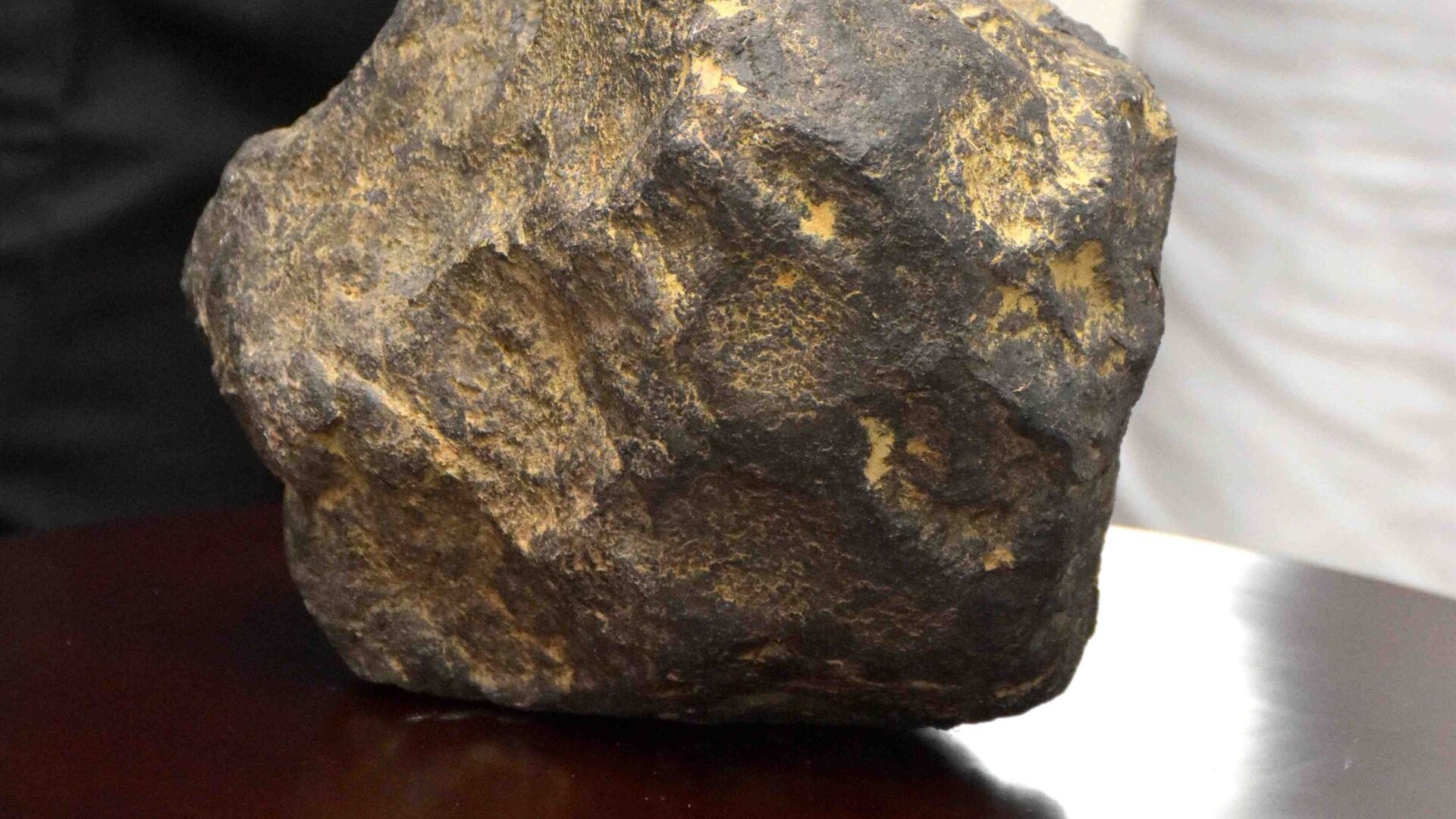https://sputnikglobe.com/20221225/at-least-two-new-to-science-minerals-discovered-in-15-ton-meteorite-found-in-africa-1105778658.html
At Least Two New-to-Science Minerals Discovered in 15-Ton Meteorite Found in Africa
At Least Two New-to-Science Minerals Discovered in 15-Ton Meteorite Found in Africa
Sputnik International
The meteorite itself was originally found in Somalia in 2020. Dubbed the “El Ali” meteorite because it was found near the town of El Ali in the central region... 25.12.2022, Sputnik International
2022-12-25T07:46+0000
2022-12-25T07:46+0000
2023-04-21T10:43+0000
africa
meteorite
somalia
east africa
horn of africa
science & tech
https://cdn1.img.sputnikglobe.com/img/107638/97/1076389726_0:281:2049:1433_1920x0_80_0_0_1484f9bc8e33e34b35ad48f0daf29c26.jpg
A group of scientists from the University of Alberta (U of A) in Canada have succeeded in identifying two new minerals that have never before been seen on Earth in a 15-ton space rock.The “phenomenal” discovery came as a result of laboratory analyses of a 70-gram slice of the meteorite received by the U of A from Somalia for scientific examination.Herd was said to have found, while studying the meteorite sample in a microscope, where he spotted some unusual elements. That prompted him to seek the help of a scientist experienced in identifying new minerals, Andrew Locock, head of the university’s Electron Microprobe Laboratory.“The very first day he did some analyses, he said, ‘You’ve got at least two new minerals in there,’” Herd narrated. “That was phenomenal. Most of the time, it takes a lot more work than that to say there’s a new mineral.”The two newly-identified minerals received the names “elaliite” and “elkinstantonite”. The first mineral took its name from the meteorite itself, which was originally named after the town of El Ali in the central region of Somalia, where the 15-ton space object crashed in 2020. The second mineral was named after Lindy Elkins-Tanton, vice president of the Arizona State University (ASU) Interplanetary Initiative, a professor at ASU’s School of Earth and Space Exploration.The scientists believe that more minerals could be discovered in the El Ali meteorite, including a potential third mineral already under examination, if more samples from the massive meteorite are handed to researchers.
africa
somalia
east africa
horn of africa
Sputnik International
feedback@sputniknews.com
+74956456601
MIA „Rosiya Segodnya“
2022
Muhammad Nooh Osman
https://cdn1.img.sputnikglobe.com/img/07e4/08/0e/1080170965_2:0:2050:2048_100x100_80_0_0_1de8233c87df0979e7e74f61b6ffacad.jpg
Muhammad Nooh Osman
https://cdn1.img.sputnikglobe.com/img/07e4/08/0e/1080170965_2:0:2050:2048_100x100_80_0_0_1de8233c87df0979e7e74f61b6ffacad.jpg
News
en_EN
Sputnik International
feedback@sputniknews.com
+74956456601
MIA „Rosiya Segodnya“
Sputnik International
feedback@sputniknews.com
+74956456601
MIA „Rosiya Segodnya“
Muhammad Nooh Osman
https://cdn1.img.sputnikglobe.com/img/07e4/08/0e/1080170965_2:0:2050:2048_100x100_80_0_0_1de8233c87df0979e7e74f61b6ffacad.jpg
meteorite, somalia, east africa, horn of africa, science & tech
meteorite, somalia, east africa, horn of africa, science & tech
At Least Two New-to-Science Minerals Discovered in 15-Ton Meteorite Found in Africa
07:46 GMT 25.12.2022 (Updated: 10:43 GMT 21.04.2023) Muhammad Nooh Osman
Writer/Editor
The meteorite itself was originally found in Somalia in 2020. Dubbed the “El Ali” meteorite because it was found near the town of El Ali in the central region of the East African country, the space object is considered the ninth-largest meteorite ever to have survived passing through the atmosphere of planet Earth and colliding with its surface.
A group of scientists from the University of Alberta (U of A) in Canada have succeeded in identifying two new minerals that have never before been seen on Earth in a 15-ton space rock.
The “phenomenal” discovery came as a result of laboratory analyses of a 70-gram slice of the meteorite received by the U of A from Somalia for scientific examination.
“Whenever you find a new mineral, it means that the actual geological conditions, the chemistry of the rock, was different than what’s been found before,” said Chris Herd, a professor in the Department of Earth & Atmospheric Sciences and curator of the Meteorite Collection at the University of Alberta. “That’s what makes this exciting: In this particular meteorite, you have two officially described minerals that are new to science.”
Herd was said to have found, while studying the meteorite sample in a microscope, where he spotted some unusual elements. That prompted him to seek the help of a scientist experienced in identifying new minerals, Andrew Locock, head of the university’s Electron Microprobe Laboratory.
“The very first day he did some analyses, he said, ‘You’ve got at least two new minerals in there,’” Herd narrated. “That was phenomenal. Most of the time, it takes a lot more work than that to say there’s a new mineral.”
The two newly-identified minerals received the names “elaliite” and “elkinstantonite”. The first mineral took its name from the meteorite itself, which was originally named after the town of El Ali in the central region of Somalia, where the 15-ton space object crashed in 2020. The second mineral was named after Lindy Elkins-Tanton, vice president of the Arizona State University (ASU) Interplanetary Initiative, a professor at ASU’s School of Earth and Space Exploration.
“Lindy has done a lot of work on how the cores of planets form, how these iron nickel cores form, and the closest analogue we have are iron meteorites. So it made sense to name a mineral after her and recognize her contributions to science,” professor Herd said.
The scientists believe that more minerals could be discovered in the El Ali meteorite, including a potential third mineral already under examination, if more samples from the massive meteorite are handed to researchers.





